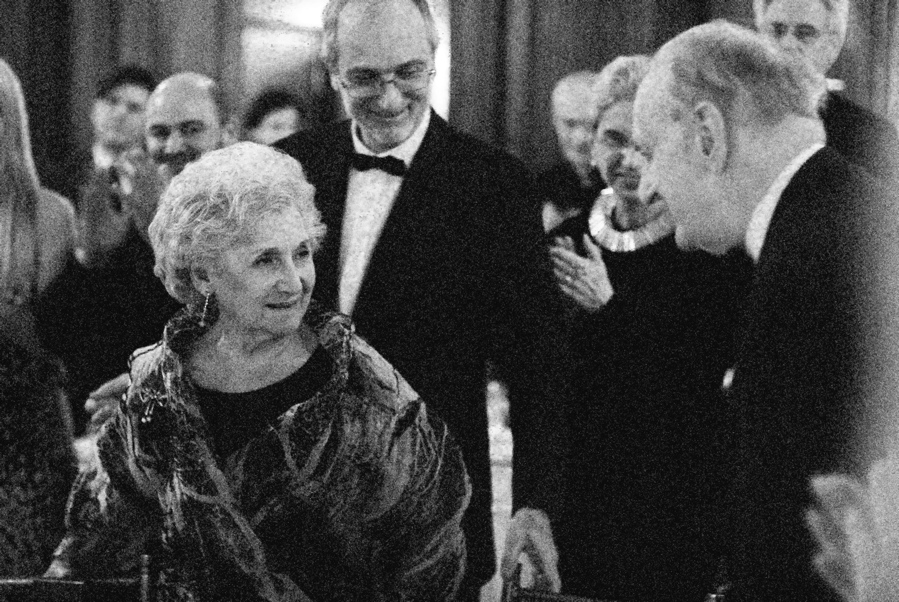Calvin Tsao on Ada Louise Huxtable
2008 President's Medal honoree
On February 5, 2008, The Architectural League of New York presented its President’s Medal to Ada Louise Huxtable. The President’s Medal is the League’s highest honor and is bestowed, at the discretion of the League’s President and Board of Directors, on individuals to recognize an extraordinary body of work in architecture, urbanism, or design.
During the awards ceremony, Calvin Tsao, League President 2006–2010, made the following remarks during his presentation of the medal to Huxtable.
We are honored to have among us this evening many of the world’s most celebrated architects—architects who have remade our skylines and enriched our lives with sublime testaments of human creativity. Yet, despite the impact of these substantial talents, there is one person here tonight who, more than anyone else, has helped shape the public’s awareness of architecture’s importance in our daily lives and its fundamental significance as part of our cultural heritage. Someone who has challenged, cajoled, instructed, humored, shamed, inspired and, yes, even scared architects, clients, and civic leaders into accepting the awesome responsibility of our built environment. That person is, of course, Ada Louise Huxtable.
Ada Louise Huxtable exemplifies the critic as critical thinker. She gives us disciplined intellectual insight that combines deep historical knowledge and a command of all relevant facts, with balanced yet passionate judgment and, when necessary, a tongue planted firmly in cheek. She has the sweetest smile, the most gracious manners, but make no mistake, this lady is fierce. When she is disappointed by a work of architecture or an approach to a planning issue, we know it. She speaks to us from a position of authority, but she never speaks down to us. Those who have spoken before me tonight have quoted a few of her more memorable zingers—I would like to treat you to a couple more:
An excellent job with a dubious undertaking, which is like saying it would be great if it weren’t awful.(It’s worth noting that this project didn’t go ahead.)
The result is a pitiful compendium of watered-down mannerisms…if there is any achievement here, it is in making the bland grotesque.
Writing about the Whitney Museum when it first opened in 1966, Ada Louise acknowledged that it was, at that moment, undoubtedly “the most disliked building in New York.” But her own reaction to the building evolved over time, a process, she said, is “like that fine old saying about sin, first the Whitney repulses, then it intrigues, and finally, it is embraced.”
Of her chosen subject, Ada Louise has said that “architecture is the art that absolutely cannot be avoided, [the art] that expresses everything that any civilization creates or leaves behind it.” But if architecture is at the center of what she writes about, it is hardly her only subject. For her, writing about architecture is writing about life.
Ada Louise is a hero in that very New York way: a hero who is at once one of us, but also makes us aspire to be our best selves.
As Ada Louise has shown us, architecture is not just about aesthetics, though aesthetics matter enormously. It is about zoning laws and building regulations and city planners. It’s about clients and their money and the influence behind that money. Architecture is about how and why certain projects are built and certain ones aren’t. It’s about how buildings are made. It’s not just about excitement for the new, though the new inspires and expands us; it is also about respect for the best of the old. Ada Louise has been the first to embrace challenging buildings that are much later widely acknowledged as masterpieces. She has also often been the first to sound the alarm when significant historic structures or districts are threatened. In many cases, she is what stood between the wrecking ball and some of our most precious architectural citizens.
Architecture is the most public of the arts, and, ultimately, architecture is about values. As Ada Louise has written, “A building is not a studio work; it is the product of an enormous mixed bag of programs and pressures that go far beyond the unified vision that is possible for the creator, performer, interpreter or translator of other art forms. It is caught in an endless struggle between the aesthetic and the pragmatic on a battlefield of politics, money and power.” And then later in the same piece: “In no field of aesthetic endeavor. . . does [the public] understand so little of what it loses because it understands so little.” Ada Louise writes to help us all understand, not only the meaning and effect of particular buildings and districts, but what is at stake in architecture and development and the way we build and then live in our cities.
This is an age sorely lacking in heroes and to many of us here tonight, Ada Louise is a hero. Ada Louise is a hero in that very New York way: a hero who is at once one of us, but also, by virtue of her sharp eye, deep knowledge of history, unfailing distaste for puffery, and many insights into both human accomplishment and frailty, makes us aspire to be our best selves.
A pioneer, a stalwart, a relentless provocateur, a tireless advocate for greatness, and an architecture-lover’s intellectual companion of a lifetime: For all this, it is my honor and privilege to present the Architectural League’s highest honor, the President’s Medal, to Ada Louise Huxtable.
Calvin Tsao
February 5, 2008
New York City

